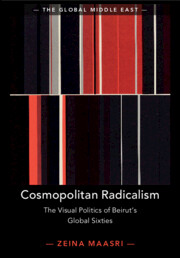Book contents
- Cosmopolitan Radicalism
- The Global Middle East
- Cosmopolitan Radicalism
- Copyright page
- Dedication
- Contents
- Plates
- Figures
- Preface and Acknowledgements
- Note on Transliteration and Translation
- Introduction
- 1 Dislocating the Nation
- 2 The Hot Third World in the Cultural Cold War
- 3 The Visual Economy of ‘Precious Books’
- 4 Ornament Is No Crime
- 5 Art Is in the ‘Arab Street’
- 6 Draw Me a Gun
- Conclusion
- Bibliography
- Index
- Plate Section
6 - Draw Me a Gun
Radical Children’s Books in the Trenches of ‘Arab Hanoi’
Published online by Cambridge University Press: 20 July 2020
- Cosmopolitan Radicalism
- The Global Middle East
- Cosmopolitan Radicalism
- Copyright page
- Dedication
- Contents
- Plates
- Figures
- Preface and Acknowledgements
- Note on Transliteration and Translation
- Introduction
- 1 Dislocating the Nation
- 2 The Hot Third World in the Cultural Cold War
- 3 The Visual Economy of ‘Precious Books’
- 4 Ornament Is No Crime
- 5 Art Is in the ‘Arab Street’
- 6 Draw Me a Gun
- Conclusion
- Bibliography
- Index
- Plate Section
Summary
Mobilized by radical networks of solidarity, stretching from Cuba, through Algeria and all the way to Vietnam and China, an anti-imperialist revolutionary subjectivity was constituted through a global flow of discourses and associated visuality. In this globally expansive revolutionary geography, Beirut — dubbed the 'Arab Hanoi' — acted as a nodal site in and through which an aesthetic of solidarity with the Palestinian liberation movement converged and circulated along transnational circuits. Chapter 6 focuses on the publications of Dar al-Fata al-Arabi, a vanguard pan-Arab children’s publishing house linked to the PLO, which launched from Beirut in 1974. It examines how it came to represent a radical node of transnational solidarity among Arab artists, intellectuals and writers committed to the Palestinian cause and to revolutionary change in the Arab world. In tracing the social life of a particular publication, entitled The Home, from production in Beirut to international itinerary accompanying Yasser Arafat’s landmark speech at the UN in 1974, the chapter reflects on the historical junctures and disjuncture of the Palestinian struggle with global politics of decolonization; the aesthetics of revolutionary armed struggle and the translocal figure of the freedom fighter; tensions between radical art and diplomacy; and last but not least, the utopias and disenchantment of a generation of politically committed Arab artists and intellectuals.
Keywords
- Type
- Chapter
- Information
- Cosmopolitan RadicalismThe Visual Politics of Beirut's Global Sixties, pp. 211 - 242Publisher: Cambridge University PressPrint publication year: 2020

